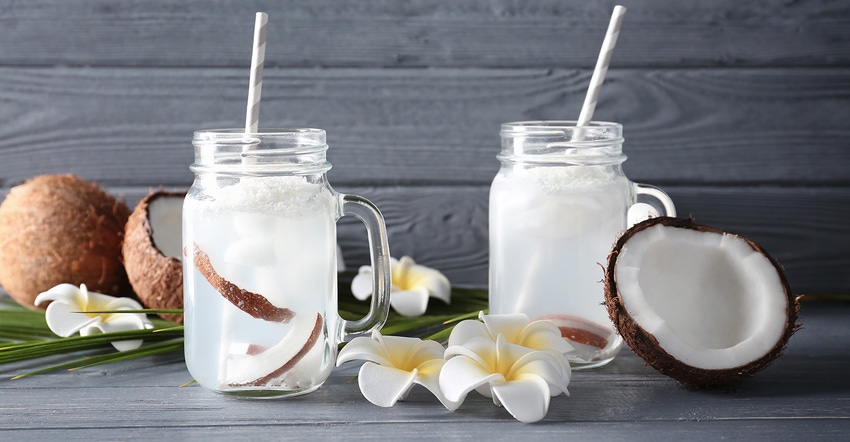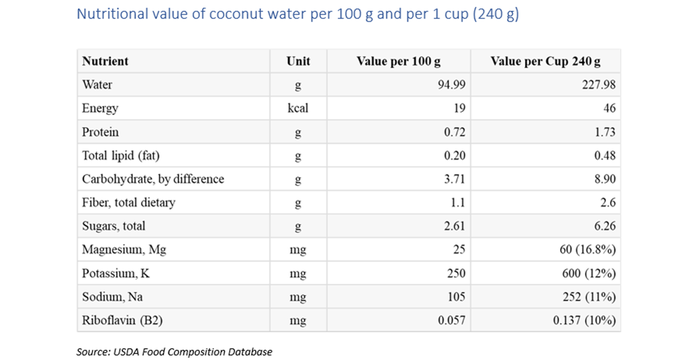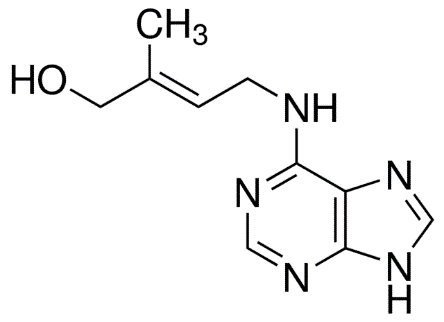Coconut water has been shown to help reduce dehydration and fight oxidative stress, but manufacturers face processing challenges.
February 1, 2019

Coconut (Cocos nucifera L.) water is a natural product. It is the liquid tissue inside a young coconut that serves as a natural reservoir of nutrients and bioactive compounds to promote growth and produce “coconut meat.”
One cup (240 ml) of coconut water is a "good source" of magnesium, potassium and sodium (electrolytes), as well as vitamin B2. Consequently, coconut water is a naturally nutritious refreshment.

Some variations in nutritional composition of coconut water is expected due to natural and environmental factors such as variety, geographical location, stage of maturity, soil, water, sunshine, etc. Therefore, it is conceivable that one cup (240 ml) of coconut water can be a “good source” or even an “excellent source” of some other nutrients.
Saat et al (2002) conducted a cross-over study to assess the effectiveness of fresh young coconut water and a carbohydrate-electrolyte beverage compared with plain water for whole-body rehydration and blood volume restoration following exercise-induced dehydration.1 These researchers found that coconut water was significantly sweeter, caused less nausea, and was easier to consume in a larger amount compared with a carbohydrate-electrolyte beverage and plain water. They concluded that ingestion of fresh, young coconut water, a natural refreshing beverage, can be used for whole body rehydration after exercise.
Interestingly, classic nutritional value tables do not mention or refer to any bio-active compound in a product. Bioactive compounds (also known as phytonutrients or nutraceuticals) provide health benefits beyond basic nutrition upon ingestion.
Alleyne et al (2005) investigated the effect of regular consumption of two tropical food drinks, coconut water and mauby, on the control of hypertension using 28 hypertensive subjects.2 These researchers found the largest decreases in mean systolic and mean diastolic pressure (24 mmHg and 15 mmHg respectively) in the group that received the mixture of both drinks.
The bioactive shikimic acid is found in coconut water. The shikimic acid pathway is related to the metabolism of carbohydrates and aromatic amino acids and has a significant role in the growth and development of the coconut.3
Shikimic Acid

Shikimic acid has three hydroxyl groups and is therefore expected to have an antioxidant property. Manna et al (2014) investigated whether and how the coconut water concentrate and its major active phytoconstituent shikimic acid could effectively protect murine hepatocytes from the deleterious effect of hydroperoxide-mediated oxidative stress.4 They found that coconut water concentrate and shikimic acid reversed the hydrogen peroxide induced oxidative damage in liver cells.
The chemical composition and biological properties of coconut water are thoroughly reviewed by Yong et al (2009).5 These researchers concluded that cytokinins (a class of plant substances that are involved in cell growth and differentiation) are the most important components in coconut water.
Lazim et al (2015) quantified cytokinins in coconut water from different maturation stages of two of Malaysia’s coconut varieties.6 All native cytokinins are derivatives of the adenine. The amount of cytokinins in coconut water was found to be maturation-level dependent. Trans-zeatin riboside was noted to be the major cytokinin compound present in coconut water for both varieties.
Trans-zeatin

Riboside

Kim et al (2008) found that a zeatin supplement improved scopolamine-induced memory impairment in mice, which suggested that zeatin might be useful in protecting cognitive dysfunction and in reducing the activation of acetylcholinesterase in dementia.7
It has also been reported that trans-zeatin prevents amyloid beta-induced neurotoxicity and scopolamine-induced cognitive deficits in mice, which suggest a possible chemo-preventive role of zeatin in Alzheimer's disease.8
Effects of cytokinins, cytokinin ribosides and their analogs on the viability of normal and neoplastic human cells was examined by Casati et al (2011).9 While cytokinins trans-zeatin did not show any effect, cytokinin ribosides, such as trans-Zeatin riboside impaired the viability of normal and neoplastic cells.
Meeting the challenges
Coconut waters available in the market are mostly from concentrate. This mean that coconut water is obtained by breaking the green (and sometimes mature brown) coconut open in the air, extracting the coconut water, thermally concentrating the recovered coconut water to a syrup (to facilitate overseas transportation), re-constituting the syrup with water back to single strength, pasteurizing and packaging the coconut water to a finished product. The not-from-concentrate coconut waters in the market skip the thermal concentration and, therefore, the reconstitution steps.
Several factors can impact the nutritional and sensory properties of coconut water from the time the coconut is broken open in the air until it is in the hands of the consumer. The longer and more intense the exposure to such factors, the more severe the adverse impact on the sensory and nutritional quality of the recovered coconut water.
Extraction stage: The extraction stage—through technology explained in U.S. patent 8,679,562—is related to penetrating the shell of a green coconut within 48 hours from harvesting via a probe (the probe has a gas inlet and an egress port) and injecting nitrogen gas under pressure into the coconut through the gas inlet, thus enabling the gas under pressure to push the coconut water to an oxygen-free collection vessel.
Distribution stage: U.S. patent 8,586,119 explains a method of distributing extracted coconut water in oxygen-barrier packages to consumers through a refrigerated supply chain. This helps prevents oxygen from contacting the coconut water.
Microbial reduction stage: According to FDA's juice hazard analysis and critical control point (HACCP) regulation, juices must be treated for five-log pathogen reduction of the most resistant microorganism of public health significance that is likely to occur in the juice (e.g., E. coli O157:H7). The five-log pathogen reduction may be achieved using different methods:
Thermal pasteurization and ultra-pasteurization (UHT) are the most common methods for juices, but, parallel to the destruction of pathogens and spoilage bacteria, heat can also affect the nutrients and bioactive compounds in the juice and can change the flavor profile of the coconut water. Pasteurization offers a limited shelf life.
A better method in terms of safety and shelf life is the cold pasteurization high pressure processing (HPP), in which the juice, already sealed in its final package, is subjected to high pressure (transmitted by water) in the range of 100 to 800 Megapascal (MPa), for up to 30 minutes (1MPa = 10 Bar or approximately 10 atmospheres). However, while the high-pressure damages and destroys DNA of bacteria, it may also affect the nutrients and bioactive compounds in the juice. The resultant juice will have a shelf life of 45 to 90 days if stored and distributed through a refrigerated supply chain.
The best method possible is cold filter-sterilization of clarified juices in absence of oxygen. In this method, instead of leaving the killed bacteria (vegetative and spores), yeasts and molds in the product, they are physically removed without any nutritional damage to the juice. This exceeds the legally required five-log microbial reduction of juices. Using an inert gas like nitrogen to eliminate oxygen from the head space of filter-sterilized juice during distribution and storage makes this the desirable five-log pathogen reduction method, because, in such juices, no microbial or chemical oxidation is expected. Filter-sterilized juices packed under nitrogen in oxygen barrier PET bottles and stored and distributed through a refrigerated supply chain should have five to six months shelf life.
Reza Kamarei ([email protected]) holds four academic degrees in the field of nutrition and food science including his doctorate in food science and technology from the Massachusetts Institute of Technology (MIT). He has R&D and management experience in the areas of functional ingredients, nutraceuticals, foods and beverages, and dietary supplements. In cooperation with sales and marketing teams, he has brought numerous products and technologies to global markets. He is currently providing consulting services to clients in the functional ingredient, nutraceutical, food and beverage and dietary supplement businesses.
References
Saat M et al. “Rehydration after exercise with fresh young coconut water, carbohydrate-electrolyte beverage and plain water.” J Physiol Anthropol Appl Human Sci. 2002;21(2):93-104
Alleyne T et al. “The control of hypertension by use of coconut water and mauby: two tropical food drinks.” West Indian Med J. 2005;54(1):3-8.
Kougan G et al. “Simple Phenols, Phenolic Acids, and Related Esters from the Medicinal Plants of Africa.” IN: Medicinal Plant Research in Africa Pharmacology and Chemistry. 2013 Edited by Victor Kuete, Elsevier, New York
Manna K et al. “Protective effect of coconut water concentrate and its active component shikimic acid against hydroperoxide mediated oxidative stress through suppression of NF-κB and activation of Nrf2 pathway.” J Ethnopharmacol. 2014;8;155(1):132-46.
Yong J et al. “The Chemical Composition and Biological Properties of Coconut (Cocos nucifera L.) Water.” Molecules 2009;14, 5144-5164.
Lazim M et al. “Quantification of Cytokinins in Coconut Water from Different Maturation Stages of Malaysia’s Coconut (Cocos nucifera L.) Varieties.” J Food Process Technol 2015;6:11
Kim M. “Zeatin supplement improves scopolamine-induced memory impairment in mice.” Biosci Biotechnol Biochem 2008;72(2):577-81.
Choi S et al. “Zeatin prevents amyloid beta-induced neurotoxicity and scopolamine-induced cognitive deficits.” J Med Food. 2009;12(2):271-7
Casati S et al. “Effects of Cytokinins, Cytokinin Ribosides and their Analogs on the Viability of Normal and Neoplastic Human Cells. Anticancer Research,” International Journal of Cancer Research and Treatment. 2011;31(10) 3401-3406
About the Author(s)
You May Also Like




.png?width=800&auto=webp&quality=80&disable=upscale)